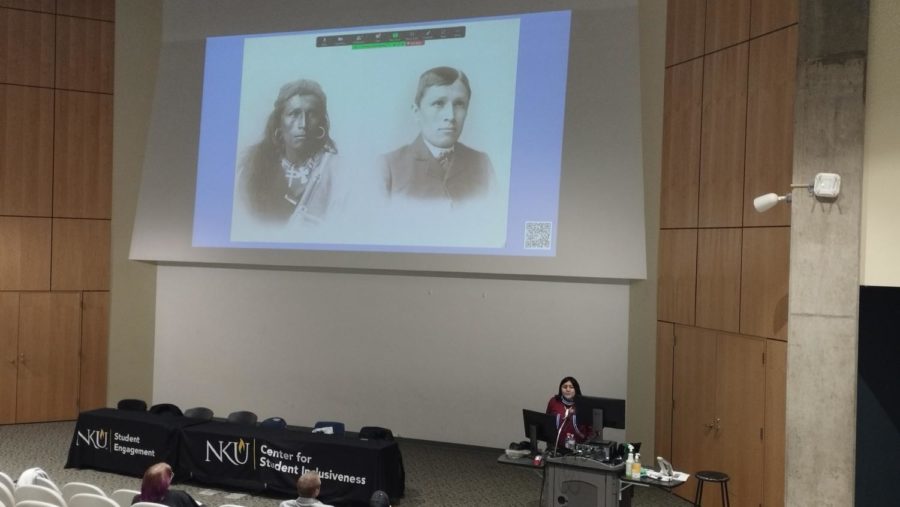Indigenous speaker shares the art of cultural storytelling
November 16, 2022
Dr. Kah-ow-dthu-ee Sippun Amanda Cheromiah presented on culturally appropriate storytelling methods on Tuesday, Nov. 15.
In a presentation that weaves personal experiences, collective history, audience participation and educational methods, Dr. Kah-ow-dthu-ee Sippun Amanda Cheromiah shared her story as well as strategies for culturally appropriate storytelling on Tuesday, Nov. 14 in the Eva G. Farris Amphitheatre.
Titled “Indigenous Storytelling: Centering the Strength and Beauty of Our People,” the hybrid event was not so much a formal presentation as a conversation, built around 10 of what Dr. Cheromiah called “Indigenous Protips” for storytelling that amplifies individual and collective narratives. As part of each strategy, the audience answered questions, voiced the details they noticed in photographs and, at one point, looked up their names on Google.
Dr. Cheromiah is a member of the Laguna Pueblo in New Mexico and currently serves as assistant senior director of the Alaska Native Science and Engineering program at the University of Alaska Anchorage: a program designed to engage Alaska Native students from kindergarteners to postgraduates. She moved from New Mexico to Arizona, and from there to Alaska, where she has been living since July.
“I’ve traveled over 3,000 miles to be here with all of you, and that is very important to me because having a sense of place, having a rootedness within the communities that I go visit is very important to me.”
Throughout the presentation, Cheromiah recalled her experiences with Indigenous communities in the places she has visited, from the Inupiat in Alaska—who taught her about the sacredness of polar bears—to the Māori in New Zealand—from whom she learned the spiritual significance of rivers and waters. Their knowledge, as well as her personal experiences, both individual and those informed by relatives and friends, ground Cheromiah as a storyteller and guide her approaches to telling narratives on behalf of other people.
“Knowing what grounds you as a storyteller is so important because when there are challenges, and there are some really hard challenges, you can recall why you share stories,” Cheromiah said. “When it gets hard, it’s important to know where you can go back to find that comfort and find the reason why you want to keep moving forward.”
She also continually engaged with the audience, two segments of which provided the core for discussion for much of the evening. The first involved attendees identifying three major events or eras that they believe shaped the United States, an exercise that Cheromiah said can be integrated into educational curricula to analyze how history is written and regarded.
The audience answered with a range of options, from the Civil War to the legalization of gay marriage in 2015. For Cheromiah, the three events that defined the U.S. are the Emergence or creation story of Native American peoples, the civil rights movement in the 1950s and 1960s, and the invention of the iPhone.
In the second participation segment, Cheromiah asked the audience to pinpoint themselves on a storytelling transparency spectrum, or how transparent they are when it comes to sharing stories about themselves, their families, their work and their pets.
“When you look at these different realms of storytelling, I think that it can change based on your audience, who you’re engaging with, who you’re telling stories for and on behalf of,” Cheromiah said, adding she is generally very open and transparent about sharing her narratives. “For many years our narratives were told for us, but now as Indigenous people we have the power to share our stories.”
Among her strategies for culturally sensitive storytelling, Cheromiah encouraged the audience to think about their digital presence, to consider how they present their names, to create new concepts and claim ownership of their content, to compensate designers and artists, to be mindful of their storytelling ethics, and to be bold in integrating cultural materials in learning spaces.
The event concluded with a showcase of some of her storytelling works—a variety of content that spans videos, websites and graphics—and an affirming message.
“I hope that if you remember nothing else, I pray that you know you are loved and that you are storytellers,” Cheromiah remarked. “As I finish here, I always honor where I came from and the relatives that I’ve had in education and beyond. I hope that hearing this will give you a sense of the great strength and beauty of our people, and that we are here, we are very strong, and our culture has always been here and will continue to be here.”
The event was hosted by the Center for Student Engagement and Center for Student Inclusiveness in partnership with the Native American Studies program—which director Eric Bates said is the only such program in the whole Commonwealth of Kentucky—in celebration of Native American Heritage Month.
According to Center for Student Inclusiveness Director Priscilla Ayala, the event realized the third pillar of student inclusiveness, that is the promotion of intercultural understanding.
“To be able to really talk about, how do we not only look at the art of storytelling, but how can we embed some of those culturally relevant pedagogies into our everyday life and everything that we do,” Ayala said.
The presentation also left a strong impression. After it had wrapped up, several attendees came up to Cheromiah with additional questions.
“I thought it was wonderful,” said anthropology major Naomie Howard. “Just learning about storytelling from a Native perspective ‘cause I’ve always been learning it from a white perspective, so it’s just really interesting to hear about storytelling and her cultural history. It’s very enlightening to me.”

